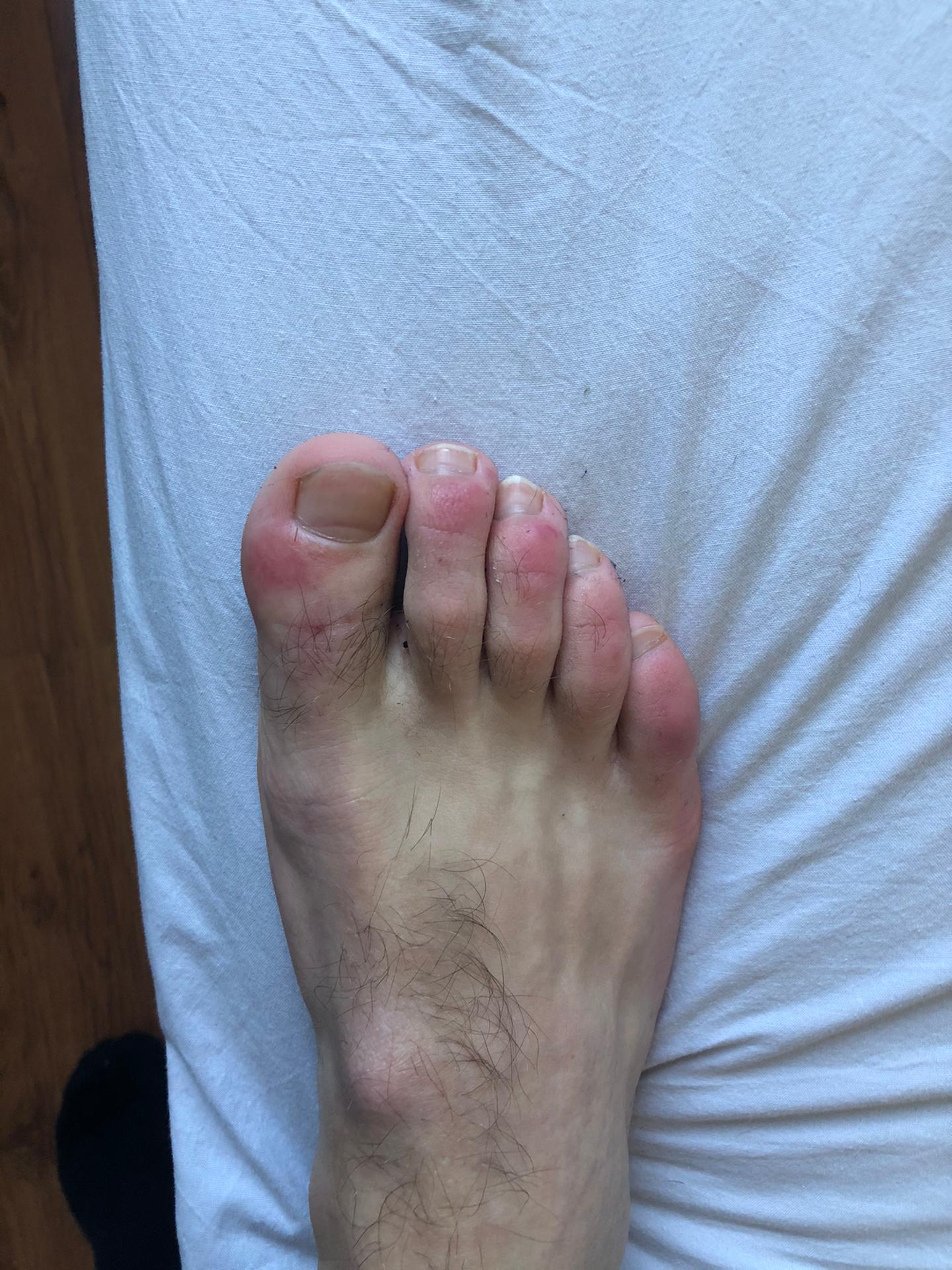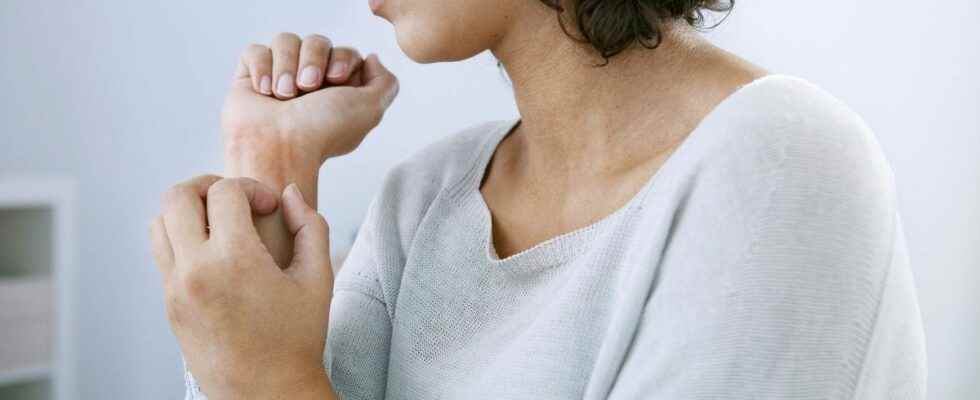Published on
Updated
Reading 7 mins.
Patients, pharmacists and dermatologists report dermatological manifestations of infection with the new coronavirus, such as urticaria or even vascular lesions at the fingertips. Manifestations of the skin to which attention should be paid.
The SARS-CoV-2 infection is far from having revealed all its mysteries. As the number of CoVid-19 cases increases, new, rather atypical symptoms are being identified. After the loss of taste and smell, digestive disorders or even conjunctivitis, urticaria and vasculitis could also be part of the clinical picture.
Skin signs
Localized or generalized hives
“There are many doctors, dermatologists or pharmacists who see cases of hives, a rash, with diffuse redness or simply on the face“, explained doctor Gérald Kierzek, emergency doctor and author of the book “Coronavirus: how to protect yourself?”, during a Facebook Live Doctissimo on the coronavirus. In a press release published on April 6, the National Syndicate of Dermatologists-Venereologists (SNDV) confirms these remarks by explaining that “a WhatsApp group of more than 400 dermatologists (liberal and hospital-university), organized by the SNDV, highlighted rashes, whether or not associated with signs of Covid. These are transient urticaria lesions.” This urticaria localized or generalized is not necessarily a sign of seriousness.
#Questionoftheday What are the “weird” symptoms of COVID19? less typical symptoms are stomach aches, diarrhea, hives and conjunctivitis. But the list is not exhaustive! And these are not signs of gravity
— Dr Gérald KIERZEK⚡ ⚕️ (@gkierzek) April 2, 2020
Frostbite-like lesions
But the SNDV also alerts on acrosyndromes. They would be associated with inflammation of the walls of blood vessels (vasculitis), themselves linked to “the inflammatory burden of the virus”, manifesting as “small red rashes sometimes painful, like chilblains, on the fingers or even by dyshidrosis, a form of eczema, on the extremitiessays Dr. Kierzek. Scientists wonder whether these manifestations are related to the severity of the disease or not, with some considering it to be a first symptom of infectious shock.”
For its part, the French Society of Dermatology (SFD) indicated in a press release published on April 8 that it wanted “confirm or not this association or possible link, by documenting very precisely these cases with the collection of the context, the history of the disease, the clinical signs and their evolution, with photos (possibly biopsies), and by exploring on the virological level clinically atypical cases, with the notion of contagion, associated, usual or unusual symptoms“.
For this, it launched the COVIDSKIN study, in the form of a national call for cases. The goal: to collect and document the skin manifestations that may be associated with COVID-19. The largest group includes “patients with frostbite-type lesions with 165 participants, including 96 women, 69 men, aged 9 to 76 years (mean age 30 years). 31 patients (19%) have already had swelling or Raynaud’s syndrome previously and in 14 cases (8%) exposure to cold in the previous days“, details the SFD in a press release. “The clinical presentation of frostbite type eruptions was classic, but the frequency of vesicular or bullous lesions should be emphasized.“, continues the SFD.
As for the link between these skin conditions and the coronavirus, the SFD advances cautiously: “in total, an eruption appearing unusually frequent in this season, not associated with any particular severity, and which can sometimes follow signs of the minimal infectious type, with for the cases explored, a single positive PCR, which does not exclude a possible previous infection, but it cannot be confirmed either. We underline the non-inaugural or revealing nature of these manifestations which do not constitute a “warning” sign, in particular when they are isolated and there is no argument in favor of a potential contagiousness of these patients.“.
Frostbite, a sign of effective immunity
On November 25, 2020, a study published in the journal JAMA Dermatology brought new information about the appearance of frostbite during a Covid-19 infection. It was conducted with 40 participants who were admitted to the Nice University Hospital between April 9 and 17, 2020 and presenting these symptoms. “If they had all been contact cases or suspected of being infected with SARS-CoV-2 in the 3 weeks preceding the consultation, the result of the search for the virus at the nasopharyngeal level (PCR) was negative for all of these participants, and positive serology was only found in a third of them“, reports an Inserm press release published on January 11, 2021. Data that suggests “a innate immunity (the body’s first line of defense against pathogens) particularly effective“.
Read also

The researchers wanted to measure the production of alpha interferons (IFNɑ; proteins produced by immune system cells) by innate immunity cells to confirm this hypothesis. Cell activity from three groups of participants was compared:those who experienced swelling, those who developed other non-serious forms of Covid-19 and those hospitalized due to this infection“.”The cells of the former show much higher levels of IFNɑ expression than those of the other two groups. The levels measured in the cells of hospitalized patients, with severe forms, are even particularly low“, says Professor Thierry Passeron, works director.
If the dermatologist notices that the “we sees the number of these frostbites increasing again in recent weeks, similar to what was observed during the first wave of the epidemic“, he insists on “reassure those who suffer from it: even if they are painful, these attacks are not serious and regress without sequelae over a few days to a few weeks. They sign an infectious episode with SARS-CoV-2 which is already over in the majority of cases. Affected individuals cleared the virus effectively and quickly after infection.“

Skin rash, seek medical advice
It’s unclear whether the effects of CoVid-19 on the skin are common or not, but the SDNV says that “the analysis of the many cases reported to the SNDV shows that these manifestations can be associated with it“.
Be that as it may, any naïve patient, that is to say anyone who has never had these manifestations, must seek medical advice. “In someone who has never had this, these symptoms become pathognomonicthat is to say that they practically sign the diseasesays Dr. Kierzek. These are witnesses of generalized inflammation. It’s a bit like anosmia (loss of smell, editor’s note) and ageusia (loss of taste): these eruptions alone can reveal the pathology but they can also be accompanied by flu-like symptoms.“But the SFD calls for caution”because any frostbite is not necessarily a sign of Covidswellings being nevertheless a fairly frequent dermatosis“.
“It is important for subjects who have skin problems of this type to consult a dermatologist (teleconsultation or other), in order to ensure that these are associated with a Covid+ syndromespecifies for its part the SNDV. We are alerting the population and the medical profession in order to detect these potentially contagious people as quickly as possible (without necessarily showing signs of breathing difficulties).“The SFD wishes it”promote the establishment of channels allowing dermatologists and general practitioners who see these patients on the front line, to send them to reference hospitals to take samples in order to test them“.
See a doctor in minutes
Medical diagnosis 7 days a week from 7 a.m. to 11 p.m.


LIVI is a doctor on your phone to take care of the most common symptoms!
You get a medical diagnosis very quickly and a prescription if needed.
Free app on iOS and Android!
Anti-inflammatories should be avoided
Faced with an attack of hives, patients are advised not to take cortisone, anti-inflammatories being suspected of aggravating the coronavirus infection. Antihistamines could be prescribed in the face of these inflammatory reactions,”but it is an empirical treatment, not validated because we have just discovered these manifestations. All this shows that this virus, we do not know it, and we do not yet know all its effects.”
How long do these skin manifestations last?
According to a study presented on October 29 at the 29th congress of theEuropean Academy of Dermatology and Venereology (EADV), “some infected people have lasting skin signs that vary depending on the type of rash due to COVID-19“, can we read in EurekAlert, which lists the latest scientific studies. Those people whose skin reactions persist for more than 60 days are called “long haul” or “long Covid”.
Data from 990 cases from 39 countries show “an average duration of 12 days for all dermatological signs, some up to 150 days“. More specifically, the researchers observed in the participants studied that the urticaria lasted an average of 5 days and the frostbite persisted for a fortnight, up to 130 or even 150 days.
As the site explains, “skin signs vary depending on the severity of COVID-19. Some symptoms, such as retiform purpura, are associated with a severe form, since 100% of these subjects were hospitalized, while COVID toes travel with relatively mild disease, with only 16% hospitalized. Additionally, although COVID toes often appear 1–4 weeks after initial infection, 15% were found to still be PCR positive.“
“Our registry has identified a subset of subjects with long standing skin manifestations due to COVID-19said Dr. Esther Freeman, principal investigator of the study. We highlight patients with pernio/frostbite, also known as COVID toes, who have been showing signs for 150 days. These data add to our knowledge of how the coronavirus can affect several different organ systems, even after patients have recovered from their acute infection. The skin can provide a visual window into inflammation that may be occurring elsewhere in the body.“
